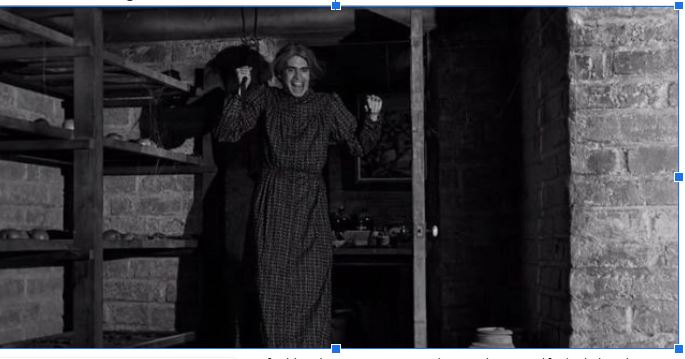What is “Queer Coding?”
Anthony Perkins dresses as a woman for his role as Norman Bates in “Psycho” By Alfred Hitchcock
September 2, 2022
Author’s note: The word “queer” has been used as a slur in the LGBTQ community. As of the past decade, people within the community have reclaimed it in a positive way to be used as a synonym for “LGBTQ.” In this text, I will be using the word in that context.
I recently had the privilege to see Harry Potter And The Cursed Child on stage in San Francisco with my friends. Once finishing the play, I and a few others agreed on something we noticed; the two main characters were undoubtedly gay.
However, there’s an issue. Throughout the play, they are not confirmed to be gay or lovers.
This stirred up the conversation because it paved the way for us to recognize a form of media we’ve all seen before, yet, never said explicitly. It’s called “queer coding.”
Queer coding is when a character’s sexual orientation is implied by significant subtext without being stated outright. Basically, they are coded as being queer, rather than being queer out loud.
Queer coding has been around for ages. In fact, it stems from the 1930s when the film industry was heavily censored by The Hays Code.
The Hays Code was created to keep the film industry “moral” and to improve and reshape Hollywood’s image from all of the immoral scandals that were happening. The Hays Code prohibited any and all depictions in films that could be regarded in any way as queer. In fact, the Hays Code censored content containing homosexuality, nudity, suggestive dances, blasphemy, the ridicule of religion, illegal drug use, mentions of STDs, interracial relationships, childbirth, detailed crime, and swearing.
But this did not stop filmmakers from creating characters that were alluded to be gay.
For example, Alfred Hitchcock queer-coded many of his villainous characters in 10 different movies. His most infamous queer-coded villain was in his movie “Psycho.” The villain, Norman Bates, dresses as his mother. Although this doesn’t seem necessarily “gay” at first, we have to dig deeper into the scene’s context. The actor who played Bates, Anthony Perkins, was a known (albeit, not entirely out), homosexual or bisexual man. Hitchcock knew this, and it was a major reason why he chose Perkins for the role. The idea of a character dressing up as a woman and being a “mama’s boy” was a perceived gay notion due to its femininity. The idea of a man being feminine was perceived as being gay. Those familiar with standard coding techniques will notice Norman’s kinship for homosexuality right away. His references to his disapproving mother stand out. Norman’s overbearing relationship with his mother is a clear allegory for his homosexuality. The queer coding in this movie is undeniable. Alfred Hitchcock is known for queer coding characters in his movies due to the Hays Code. Other examples can be seen in his movies Rope, Rebecca, and Strangers On A Train. Most of which are villainous characters.
Anthony Perkins dresses as a woman for his role as Norman Bates in “Psycho” By Alfred Hitchcock
As of now, more and more people have begun to realize how problematic it is to villainize queer characters. After all, having the only queer-coded character being bad doesn’t do much good for the LGBTQ+ community. But back then, this was the only content queer people could get without it being censored.
As I look back at Harry Potter And The Cursed Child, I can’t help but remember the concept of queer coding and its history. Although the Hays Code ended in 1968, nearly 54 years ago, the damage is done and it can still be identified in modern pop culture.
Knowing JK Rowling, the author of Harry Potter, for being a transphobic woman and a known TERF (Transgender exclusionary radical feminist), it is not surprising for her to exclude queer people from the picture. Although she did not write Harry Potter And The Cursed Child herself, it is implied that the two main characters, Albus and Scorpius, are lovers. And both the show and novel have received criticism for the blatant queer coding.
Although I enjoyed watching the show and I had a great time watching it with my friends, it’s hard to ignore the queer subtext within the show. I hope for a future where queer people don’t have to rely on queer coded characters for representation. I hope that in the future, queer representation can be explicit and not implied.



Janet Headington • Sep 2, 2022 at 4:09 pm
Thanks for attending the play, enjoying the day, and writing such a powerful piece. “Art is the lie that enables us to realize the truth.”
In solidarity…
Kiki • Sep 2, 2022 at 1:26 pm
Great article, thanks for your insight! Totally agree in this matter as well. The more LGBTQ+ folks are out there (in all their glory) the better our world will be!
Corinna Carlile • Sep 2, 2022 at 9:18 am
I totally agree with your take on the show. I was there as well and my first thought was why won’t they let Albus and Scorpius kiss? They had no problem showing kissing between the straight characters. I also had reservations about supporting the show or any of the Harry Potter books in light of the fact that Rowling is transphobic. I do have a lot of love for the series and think it is an incredible world, but I completely disagree with Rowling’s take on feminism. Transphobia is wrong.